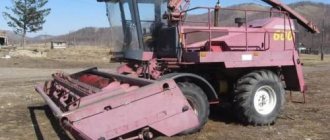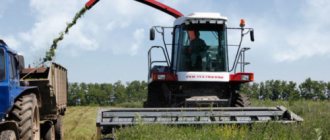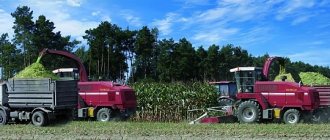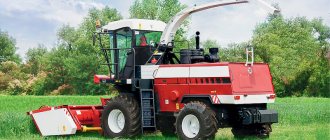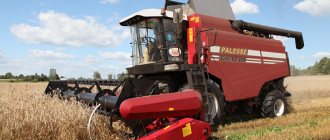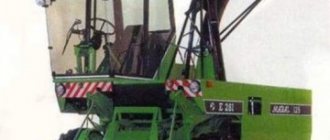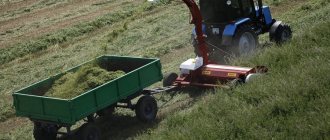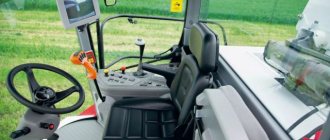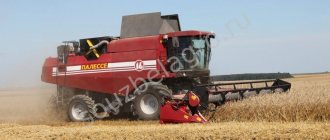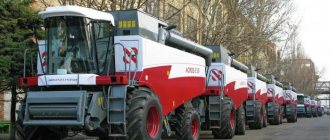- Harvesting
- Corn harvesting methods Harvesting corn on the cob
- Grain harvest
- Silage collection
- New Holland combine
About the manufacturer of this trailed combine harvester
The Gomselmash holding is one of the largest manufacturers of agricultural machinery, not only in the CIS, but throughout the world. It produces grain and forage harvesters, cob and potato harvesters, seeders, mowers and other agricultural equipment. In total, there are 16 types of agricultural machines, 75 basic models and modifications, 70 types of adapters and devices for harvesting various crops.
Possessing an extensive range of modern production technologies, Gomselmash produces all the main parts and components of its equipment independently, without purchasing “from different Chinas and Europe.” This helps the process of quality control, the production of different types of agricultural machinery at the same time, and maintaining affordable prices for products.
The holding includes the following enterprises: Gomselmash, Gomel Casting and Normal Plant, Lidagroprommash and Yubileiny-Agro.
Agricultural machinery of the Gomselmash brand is sold and operated in many countries of the world: Russia, Ukraine, Kazakhstan, Czech Republic, Slovakia, Romania, Bulgaria, the Baltic republics, Argentina, Brazil, China, South Korea and others. The holding has created a large distribution network, a number of assembly plants and joint ventures.
One of them is Bryanskselmash. Since 2005, this plant has shown an example of successful integration of Russia and Belarus. It assembles, produces and sells a large range of agricultural machinery from Gomselmash and spare parts for it, and also provides warranty and service maintenance for all these products.
Since 2016, Bryanskselmash began to produce its products under a new brand – “Desna-Polesie”. To emphasize that agricultural technology belongs to the Bryansk region. Therefore, those KDP-3000 Polesie forage harvesters that were produced by Bryanskselmash since 2016 are called Desna-Palesse FT40.
Aggregation and configuration options
The KDP-3000 Polesie combine harvester is combined with tractors of traction classes from 2 to 5, which are equipped with an independent PTO-3 shank GOST 3480 with a rotation speed of 1000 rpm, and have an engine with a power of 110-185 kW.
The combine of this model consists of: a trailed chopper, a continuous-cut rotary header for harvesting coarse crops, a platform-type header for harvesting herbs and a pick-up.
Depending on the order, the combine is supplied in different types of configuration.
- KDP-3000 – Harvester for coarse crops PKK 0200000A; Trailed chopper KPT 0000010B; Pickup PKK 0350000 and Grass Harvester KPT 0460000.
- KDP-3000-K1 – Harvester for coarse crops PKK 0200000A; Trailed chopper KPT 0000010B and Pick-up PKK 1900000.
Depending on the brand of tractor with which the combine is planned to be regularly coupled, the following are supplied upon separate order and for a fee:
- Harness device KPT 0109000V – for tractors such as T-150, T-150K, T-150K-9, KhTZ-160, KhTZ-170, KhTZ-17221, KhTZ-18040;
- Harness device KPT 0109100 – for LTZ tractors;
- Trailed beam KPT 0109070 – for tractors Kirovets K-700, K-701, etc.
Any components of a trailed combine (chopper, headers or pick-ups) can be supplied on separate orders and for an additional fee.
Self-propelled silage harvester KSK 100
The production and modernization of the KSK 100 forage harvester took place in the 70-90s of the last century. The Gomselmash technique is popular to this day. The equipment is used for mowing grass, sunflowers, corn and other silage crops, with their simultaneous chopping and unloading, as well as collecting windrows, dried seeded and naturally sprouted herbs.
Equipment characteristics
The forage harvester is designed with a chassis and two driving and steered wheels, an SMD-72 diesel engine and a chopper. The model is equipped with replaceable work tires and headers with a grip width of 3.2 and 4.25 m. The smaller one is used for corn and sunflowers, and the larger one is used for cutting grass. A grinding unit with a spreader is also provided. There is a trolley for transporting reapers.
Peculiarities
- The ease of operation of the silage harvester allows you to reduce the time frame for operator training.
- Effective and high-quality cleaning with minimal losses.
- Increased maintainability and availability of all necessary components.
- Low resource costs.
- Rear-wheel drive equipment is optimal for dry soil. When operating on wet ground, the front wheels may dig into the ground.
- To obtain smaller silage, it is necessary to upgrade the device with additional trimming units.
This model of silage harvester has various modifications, the parameters of which are close to the basic model, while the improved units are characterized by increased functionality and efficiency when performing harvesting activities.
Features and advantages of forage harvesters KDP-3000 Polesie
Since this combine is aggregated with any tractors from the 2nd to the 5th traction class, it provides excellent opportunities for preparing chopped feed, with the maximum load of the tractors available on the farm.
The radial-disc type grinding apparatus ensures the highest quality of grinding of green leafy mass and crushing of corn grains. The arrangement of the knives and throwing blades of the combine is radial.
A high degree of grinding of the feed mass optimizes the filling capacity of vehicles, thereby reducing the number of trips, and, in general, machines or tractors involved in transporting silage or haylage; and also saves diesel fuel.
The detectors of stones and metal objects, provided in the design of the combine, reliably protect the feeding and grinding apparatus from the ingress of these dangerous objects that can cause emergency breakdowns.
Combine harvester "Jaguar"
This combine is produced by the German manufacturer Clsss. It has a very high build quality and is designed to last for as long as possible. Jaguar is the best-selling silage harvesting equipment in the world due to its high technical characteristics:
- operating speed up to 16 km/h;
- Mercedes diesel engine with a power of 412 hp;
- transportation speed up to 40 km/h;
- drum for chopping plants with 24 knives;
- spacious fuel tanks (1150 liters);
- grain grinder with 100 teeth;
- grass and corn headers;
- stone detection detector;
- The silo pipeline has a turning radius of 190 degrees, which provides maximum convenience when loading silage;
- The productivity of this equipment is 114 tons per 1 hour (silage).
The combine is recommended for use on areas of 1.5 hectares or more.
Technical specifications in numbers
- Overall dimensions of the combine in transport condition: length – 10.15 m; width – 4.44 m; height – 3.65 m.
- Overall dimensions in working condition (with the silo pipe turned to the left): with a mounted header for coarse crops - length 6.2 m, width 6.3 m, height 4.3 m; with mounted pick-up – length 6.2 m, width 6.3 m, height 4.3 m; with mounted grass header – length 6.2 m, width 7.05 m, height 4.3 m.
- Weight: trailed chopper – 3100 kg; headers for coarse crops – 1250 kg; grass harvesters KPT 0460000 – 1250 kg; pick-up PPK 0350000 – 630 kg; pick-up PPK 1900000 – 700 kg.
- Coupling with tractors, traction class – from 2 to 5.
- Optimal engine power – 110-185 kW (150-250 hp)
- Adapters: reaper for harvesting rough-stemmed crops, working width: 3 meters; pick-up PPK 0350000: 1.85 meters; pick-up PPK 1900000: 2.6 meters; grass harvester: 3.4 meters.
- Installation height of the cutting apparatus: headers for coarse crops – from 120 mm; headers for grass harvesting – from 60 mm.
- The number of rollers of the feeding apparatus is 4 pieces.
- The maximum number of knives on the knife disk / throwing blades is 12 / 12 pieces.
- Cutting length range: with 12 knives on the disk – 5...9...12 mm; with 6 knives on the disk – 10…18…24 mm; with three knives on the disk - 20...36...48 mm.
- The height of loading chopped green feed into vehicles is at least 3.6 meters.
- Movement speed during operation: no more than 10 km/h.
- Transport speed: no more than 20 km/h.
- Combine wheel tires, size: 16.5/70-18 G0ST 746Z-80
Models of trailed forage harvesters
Equipment manufacturers are developing maneuverable trailed forage harvesters for MTZ, among which the following models can be distinguished:
Models SK-2.6 and SK-2.6A
Trailed forage harvesters of this series are equipped with a working width of 2.6 m. They are designed to work with various crops growing in all regions. The exception is areas where irrigated agriculture is carried out, as well as areas with maximally moist soil, such as the Far East. It is advisable to use the equipment in areas with flat terrain.
Peculiarities
- Despite the high productivity, the operation of units in small areas with irregular configuration and uneven terrain is quite complicated.
- The use of the presented forage harvesters is not productive for harvesting crops whose yield exceeds 300 centners per hectare, since the working width of 2.6 m may not be full.
- They are rarely used for working with low-growing grass and legume-cereal mixtures. It is worth noting that harvesting a laid mixture of oats and peas can result in losses of up to thirty percent.
Model SK-1.8
The SK-1.8 trailed silage combine is designed with a working width of 1.8 m. It is quite maneuverable and has high maneuverability.
The design of the unit is capable of ensuring the lowest possible cutting of plants. This configuration of the forage harvester is optimal for areas where crops are cultivated in small areas with uneven terrain, such as the northwestern regions, the central black soil belt and others.
Trailed chopper
The trailed chopper of the KDP-3000 Polesye combine consists of the following parts: trailed chassis, chopping mechanism, silo line, electrical equipment, hydraulic equipment and hanging mechanism.
The basis of a trailed shredder is a trailed chassis, which rests on 2 running wheels. It consists of: a frame, an adapter frame with a mechanism for turning the silo pipeline, a linkage, a mechanism for lifting the chopper, and a gear mechanism for driving the working parts.
The frame is a tubular beam with axles welded to it. Brackets for attaching torsion bar levers, intermediate rods and couplers are welded to the rear part of the frame, and brackets for attaching hydraulic cylinder rods are welded to the front part.
The transition frame is mounted on the torsion bar arms and connected to the main frame using hydraulic cylinders and couplers. The chopper is mounted on the transition frame.
The snitsa is a welded volumetric structure of a bent profile. Its middle part consists of a square tube in which a shaft with splined ends is located on bearings for installing forks for fastening cardan shafts. There is a tool box under the lashing. A jack is mounted in the front part of the hitch, which serves as a support when disconnecting the combine from the tractor.
The tongue is pivotally connected to the frame of the combine and is fixed in three positions: working (extreme left), transport (extreme right) and working for functioning with a harvester of coarse crops on three rows (the main cardan shaft and the shaft of the tongue are on the same line, and the tongue is fixed by a limiter ).
The wheels of this combine are discless, for wide-profile tires. They are attached to the hubs with clamps and nuts on the hub studs. The hubs are mounted on tapered bearings on the axles of the combine frame beam.
Description of the model E-"MARAL-125" (E-281 "MARAL-125")
SPECIFICATIONS
| Dimensions: | |
| Length of the main machine (with silo line), mm | 5660 |
| Width of the main machine, mm | 2700 |
| Maximum height of the upper edge of the silo, mm | 3950 |
| Weight without attachments, kg | 5260 |
| Grinding unit: | |
| Feeding and pressing rollers | 8 |
| Width of the feeding unit, mm | 580 |
| Chopping drum width, mm | 600 |
| Diameter of the grinding drum, mm | 800 |
| Rotation speed of the chopping drum, rpm | 830 .. 911 |
| Number of knives (optional) | 12, 8, 6, 4, 3, 2 |
| Feed grinding length, mm 5.5 | 153 |
| Possibility of switching the speed of feeding organs | 3 steps |
| Grinding method | mechanical |
| Rotation range of the silo | 200° |
| Electro-hydraulic control of the silo and double canopy | |
| Transmission: | |
| Chassis | 3 forward gears / 1 reverse gear |
| Speed adjustment is smooth, mechanical variator | |
| Speed, km/h | 1,5 – 21,5 |
| Tire dimensions: | |
| Drive wheels | 18-20 10PR A 19 ES |
| Driven wheels | 10.0/75-15-8 PR/impl. |
| Steering hydrostatic | |
| Fuel tank capacity, l | 185 |
| Diesel engine: | |
| engine's type | YaMZ-238 (Russia) |
| Engine power, kW | 140 |
| Engine speed, rpm | 2200 |
| Working volume, cubic dm | 14,86 |
| Attachments (adapters): | |
| Roll pick-up | PTF-2.2 |
| Grass harvester | ZhTF-4,2 |
| Corn Rotary Harvester | ZhKE-3.0 |
The E-281 “MARAL-125” forage harvester is an improved type of the E-280 forage harvester, which has proven itself in Russia. It is equipped with a metal detector and a foreign body trap to protect the grinding unit from metal and other foreign objects. The combine uses an extended silage pipeline that can be rotated by 200° and has a hydraulic drive for the ejection direction hood. “Maral-125” provides a grinding process (cutting and ejection of feed mass) with a high efficiency and guarantees a nominal throughput of green feed - 60 t/hour, dried feed - 43 t/hour and corn for silage - 60 t/hour. With good harvesting organization, “Maral-125” can provide up to 15,000 tons of feed per year.
Additional equipment Universal crushing device UNICREKER, which has become the second generation of a system of devices with flattening rollers. Thanks to the new form of crushing rollers, equipped with several meshing and replaceable conical disks, it is possible to increase the length of the crushing gap by more than 2.5 times with a constant roller width, as a result of which UNICRACKER has a very high throughput. Therefore, UNICREKER is able to universally produce high-quality feed from all types of grain crops.
Combine lifting mechanism
When the hydraulic cylinder rods extend, the transition frame with couplers and intermediate rods rises upward due to the presence of longitudinal grooves in them. After the gaps are selected in the grooves, the screed does not make it possible to continue lifting, and an angular rotation of the transition frame occurs. This allows the chopper to be raised and the adapter attached to it to be tilted backwards to move the chain into the transport position.
To fix the transition frame in the transport position, the fingers located in the brackets on the frame next to the torsion bar are installed in the holes of the brackets under the torsion bar arms.
The drive of the working parts is carried out from the tractor PTO. The main cardan shaft of the combine drive is equipped with spring clamps on both sides, connected to the pin shaft journal on one side and the tractor PTO shaft on the other.
When disconnecting the combine from the tractor, the cardan shaft remains on the hitch.
The cardan shaft of the drive of the first bevel gearbox is installed by connecting the hinge fork with the journal of the drive shaft and the flange fork through an elastic sleeve-pin coupling (to dampen vibrations) with the input shaft of the gearbox.
The drive shaft of the second bevel gearbox is located between 2 bevel gearboxes and is connected by hinge forks to the output shaft of the first and the input shaft of the second gearbox. The second bevel gearbox is located on the adapter frame plate.
The cardan shaft is a double joint, which is connected by a hinge fork to the output shaft of the second bevel gearbox, and by a flange to a safety coupling on the shaft of the grinding apparatus.
This gear mechanism uses single-stage bevel gears.
Chopper
The chopper crushes the plants and delivers the chopped feed into the back of a truck or tractor trailer. It consists of:
- 3-speed gearbox, which is coupled to a spur gearbox,
- drive mechanism of working bodies,
- silo bases,
- feeding and grinding apparatus.
The three-speed gearbox stands on the frame of the chopper, receives rotation through a belt drive from a pulley on the shaft of the chopper and transmits torque to the working parts. It has three operating speeds and reverse. Operating speeds are set manually using the gear shift lever handle. Operating speeds are activated by engaging the moving gear with the transmission gear.
The feeding apparatus compresses and feeds the feed coming from the header or pick-up into the chopping apparatus. The upper rollers are hinged to the body, ensuring their independent movement in the vertical plane with uneven thickness of the feed mass flow. Springs are used to press the feed mass using toothed rollers. A stone detector sensor is placed on a special bracket of the feeding apparatus.
The feed apparatus rollers are driven by cardan shafts from a 3-speed gearbox through a spur gearbox to the gearboxes of the lower and upper rollers. The cardan shafts have built-in clutches: safety and quick stop.
The three-speed gearbox is connected to a cylindrical gearbox, which has 4 output shafts: 2 lower ones - for connecting the drive shafts of the feed rollers, and 2 upper ones - for connecting the drive shaft of the adapters mounted on the chopper.
The chopping apparatus consists of a chamber, a chopper rotor, a cowling bar and anti-cutting plates. The grinding chamber is formed by the front and rear walls of the frame, lower and upper casings, and an adjustable tray. There is a window in the front part of the chamber through which the plant mass enters the chopping apparatus.
Depending on the operating conditions, smooth sheets or graters are installed in the lower casing and the adjustable tray of the grinding apparatus chamber.
The rotor of the grinding apparatus consists of a knife disk, with 12 knives and 12 throwing blades bolted to it. The chopping apparatus can also work with a smaller number of knives - then they need to be removed in pairs so as not to disturb the balancing of the knife disk. The rotor is mounted on a shaft with a key.
The shaft rotates in bearings, the housings of which are fixed to the front and rear walls of the chamber. Between the front bearing housing and the blade disc on the rotor shaft there are disc springs and a thrust washer.
Between the rear bearing and the blade disc there is a locking spring and an adjusting nut, with which the rotor moves along the shaft when adjusted. A drive pulley for working parts is installed on the shaft. At the factory, the shaft and rotor are selected in pairs so that the clearance along the seating surface is from 0.004 to 0.022 mm. The rotor and shaft are replaced with a pair selected at the factory.
A sharpening device is installed on the front wall of the chopping apparatus chamber to sharpen the chopping apparatus knives.
The silo line serves to redirect the flow of crushed mass into the vehicle body. It is a chute with a hinged double visor, which is designed to evenly distribute the crushed mass in the body or trolley.
Harvester "Don"
The Russian company is engaged in the production of self-propelled combines for harvesting Don 680 M silage. This combine is designed for preparing feed for livestock in quantities of up to 500 heads. It has the following technical characteristics:
- operating speed up to 9 km/h;
- the presence of three modes of chopping plants without the need to replace knives. The operator only has to select the desired mode without even leaving the cab;
- transportation speed up to 20 km/h;
- YaMZ diesel engine with a power of 290 hp;
- The silo pipeline has a turning radius of 180 degrees, which provides maximum convenience when loading silage;
- the productivity of this equipment is 100 tons per 1 hour (silo);
- thanks to the presence of pressure springs, losses of raw materials are minimal even with strong gusts of wind;
- The combine is fully adapted for domestic climatic zones.
Also, the Don combine for harvesting silage is completely unified with other equipment produced at the Rostselmash enterprise, which makes it possible to interchange almost 60% of the parts. It also has a relatively affordable price and a 24-month warranty.
The only “cons” include the low power of the motor, the small number of knives that are installed on the chopper and the need to regularly replace sprockets, gears and pulleys.
Hydraulic system
The hydraulic system of the combine is used to raise and lower the combine itself; visor of the silo pipeline, as well as for transferring the silo pipeline to the transport or working position; to control the silo pipeline rotation mechanism.
The hydraulic system of the combine is connected to the hydraulic system of the tractor using three quick-connect coupling halves. In this case, a single hydraulic outlet of the combine hydraulic system (to control the mechanism for raising and lowering the combine) must be connected through a half-coupling to one of the sections of the tractor distributor, and a pair of hydraulic outlets must be connected to the next free section.
Electrical equipment
The electrical equipment of the combine consists of a combined protection and control system for the combine. It includes a metal detector and signaling devices.
The metal detector includes: electronic unit; metal detector sensor (in the front lower roller); stone detector sensor (on a special bracket of the feeding apparatus); reed position sensor; quick stop electromagnet; executive electromechanism; Remote Control; harnesses - intermediate and output.
Harvester for coarse crops
The header for coarse crops is used for mowing corn, sunflower and other tall and coarse crops. It can be supplied in 2 versions: with passive side dividers or active side dividers.
The main working parts of the header are 2 drums, at the bottom of which there are cutting rotors. The reaper cuts the plant mass and sends it to the chopper. The rotors and drums rotate from the cardan shaft of the chopper, receiving rotational energy through a cylindrical and 2 bevel gearboxes. The helical gearbox is equipped with two input shafts, making it possible to combine options for connecting the cardan shaft from the 2 output shafts of the chopper helical gearbox to change the cutting length under different operating modes.
Design and principle of operation
The operation of the combine, the basic layout of which is shown in the diagram of the combine, is carried out in motion.
The operating principle of the forage harvester mechanism is as follows:
— the reel (1) tilts the plant stems against the progress of the combine and places them on the cutting device (2);
— the cut fragments fall into the narrowing auger (3), which structures the silage mass and feeds it to the feed rollers (4);
— ordered stems are compressed in a system of compacting rollers (5) and directed into a drum (7);
— cutting of the stems occurs when the drum rotates, on which knives are installed in a spiral. Effective cutting is achieved by using a shear plate (6);
— fragments of the silage mass fall into the silo pipe (8) and are discharged into the receiving device (usually the body of a truck).
Scheme of the KSK-100 combine
An increase in movement speed leads to an increase in the processed plant mass, which leads to the production of larger silage cuttings. To minimize the size of plant particles (up to 5 mm), the speed of movement should be reduced to the minimum values established experimentally.
Since the ingress of foreign objects leads to breakage of the drum knives or accelerated failure, their number is sometimes halved (from twelve to six). Working with dried grass requires installing an exhaust fan behind the drum, thereby increasing the efficiency of extracting the chopped mass.
Visualized operating cycle of the KSK-100 combine
Grass header
The grass header cuts grass and other low-growing forage crops. The platform-type header consists of a frame, a four-blade rake reel, a cutting device, an auger and gear mechanisms.
The drive of the header comes from the cardan shaft of the chopper to the gearbox and counter-drive. From the counter drive, rotation is transmitted by a chain transmission to the auger and a V-belt transmission to the cutting device drive pulley. The rotational motion of the shaft is converted into reciprocating motion using a swashplate, fork, connecting rod and suspension.
When a tractor with a combine harvester attached to it moves, the cutting apparatus of the header for coarse crops cuts off the plant mass, and the feed drums direct it to the rollers of the feeding apparatus. There the feed mass is pressed and enters the grinding apparatus. And the crushed feed mass is fed through a silo line into a car body or tractor trailer.
Instead of a harvester for coarse crops, you can attach a herb harvester or a pick-up to the chopper.
Operation of corn harvesters
The combine is mounted with special headers on a level area using tie-down hooks. Next, the machine is run in and the operating condition is checked: the bearings and gearboxes are heated, the angle of inclination of the cutting knife relative to the ground line is adjusted.
A device without maintenance should not be allowed for field work; this can lead to crop loss, decreased soil quality and uneconomical fuel consumption. Caring for nature and a professional approach to agricultural production are the key to an excellent harvest!
Reviews of forage harvesters Polesie KDP-3000
Judging by reviews from farms in Russia and Ukraine, a trailed forage harvester of this model is a good solution for anyone who wants to maximally load the tractors at their disposal.
The serious energy content of this combine, combined with its fairly simple and reliable technological scheme, ensures its successful use in the preparation of haylage, silage and green fertilizer for cattle. A universal type tow hitch helps to quickly connect the KDP-3000 Polesie combine harvester with all kinds of tractor models common on peasant farms without additional equipment.
When moving from one field to another, as well as on ordinary public roads, the KDP-3000 Polesie combine does not require dismantling adapters and folding the silage pipeline. The time it takes to transfer it from working to transport state, and vice versa, takes only five minutes, no more.
This is a high-quality equipment that performs as stated. The price is not prohibitive, maintainability is good. If this is also accompanied by a good local dealer who provides decent service, quickly responds and solves problems - in a word, he is engaged not only in sales, but also in full support of equipment during its operation.
For mowing silage crops, picking up from windrows, crushing and loading the harvested mass into vehicles, self-propelled forage harvesters KSK-100A, KSK-120, KSG-F-70, E-281S (GDR), trailed forage harvesters KPK.U-75 are used , K.PI-2.4, KPM-2.4, forage harvesters KS-1.8 “Vikhr”, KSS-2.6, KSG-3.2, KSKU-6, as well as mower-choppers KIR-1 ,5, KUF-1,8. The crushed mass is used to prepare silage, haylage, grass meal, and also for feeding to livestock as green fodder.
Purpose and characteristics . Silage harvesters are designed for harvesting corn, sunflower and other silage crops of continuous and row crops for silage with simultaneous chopping and loading into vehicles or picking up dried grass from windrows with subsequent chopping and loading into a trailer.
silage harvester KS-1.8 “Vikhr” is designed for harvesting various crops for silage. It can successfully replace special machines for mowing and chopping plants for the preparation of grass flour, green fertilizer, and for selecting dried grass from windrows with subsequent grinding. To perform these works, replaceable kits are installed on the combine, supplied according to individual customer orders.
The KSS-2.6 trailed high-speed forage harvester is a modification of the KS-2.6 and has the same design and technological schemes. It differs from the KS-2.6 in its reinforced frame and tongue, increased tire size, and the design of the conveyor tensioning device. In the grinding apparatus, the arrangement of knives on the middle sections of the drum has been changed. The rotation speeds of the beater and roller have been increased, which has increased the throughput of the feeding apparatus. Designed to perform the same technological operations as the KS-1.8 “Vikhr”.
The KSG-3.2 self-propelled forage harvester differs from the ones described above in its highly cross-country crawler tracks, 73.6 kW (100 hp) diesel engine, metal hopper with a capacity of 9 m3 with a rear two-section valve and a chain-slat conveyor. The bunker is equipped with a light and sound alarm that notifies the driver when the bunker is filled with crushed mass. The knife drum of the grinding apparatus is two-sectional, with four knives installed on each section. Continuous cut header with mowing type cutting device.
mower-chopper KIR-1.5B (NRB) is created on the basis of the KIR-1.5 and differs from it in the presence of a hopper with a capacity of 4.5 m3 for collecting the chopped mass and unloading it into vehicles. Designed for mowing and simultaneously chopping potato and beet tops for direct feeding to animals. Can be used for harvesting low-stalked corn, for selecting and chopping dried grass from windrows.
The KSK-100A self-propelled forage harvester includes a self-propelled chopper with a SASch-72 diesel engine, two headers 3.2 m wide each for harvesting low- and high-stem crops, a pick-up, a replaceable chopping apparatus, and transport carts for transporting the headers.
This is how the combine works. The plant mass is captured by the spring teeth of the reel and brought to the cutting device. The cut mass is fed into the auger and through a system of feed rollers and enters the chopping drum. The knife drum, with the help of a shear plate, chops the mass and throws it along the silo chute into a vehicle moving nearby or attached to the combine. The uniformity of weight distribution in the vehicle body is adjusted by the operator by turning the silo and deflector. The operating speed of the combine is 12 km/h, the productivity when mowing grass is 36 t/h, corn - 90 t/h, and picking up grass - 50 t/h. The cutting height is adjustable from 50 to 150 mm, and the cutting length is adjustable from 5 to 100 mm.
The crushed mass is transported to the storage site in cars, tractor-trailer carts or special container trailers.
Technological diagram of the self-propelled forage harvester KSK-100A : 1 - cutting device; 2 - reel; 3 - auger; 4 - feed rollers; 5 – under the pressing roller; 6 - smooth roller; 7—contradictory plate; 18 — grinding drum; 9 - silo pipeline; 10 - deflector.
For the preparation of silage and haylage, a forage harvesting complex SOZH , consisting of a KS-1.8 “Vikhr” combine and two PSE-12.5 container trailers. The carrying capacity of the container trailer is 4 tons, the body capacity is up to 12.5 m3.
Three methods of silage are used: ground, trench and tower . Above-ground silage in piles and mounds is recommended in those places where groundwater comes close to the surface of the earth. With this method, there is no need to build a storage facility; the laying of silos is mechanized. Its disadvantage is large silage losses (up to 30%).
The smallest losses of silage are observed when storing in towers , but at the same time the process of loading the towers and unloading the silo becomes more complicated. In addition, the construction of towers requires additional costs. The towers are built from brick, wood, rubble stone, reinforced concrete slabs and sheet iron, their capacity ranges from 420 to 4200 m3. The industry produces the BS-9.15 tower. The technological set of tower equipment includes a TZB-30 pneumatic conveyor for loading mass, an RMB-9.15 mass distributor and an RBV-6 unloader.
Purpose and characteristics . A set of mechanized means of a haylage tower for loading.
Feed dispenser-feeder KTU-10P is designed for receiving chopped plant matter and dosed feeding into a pneumatic conveyor-loader. It is a converted feed dispenser KTU-10, in which the tractor mechanical drive is replaced with an electric one and the feed dispenser itself is placed on a foundation.
The T3B-30 pneumatic conveyor-loader for silage towers is used to receive crushed mass from the feeder and feed it through the loader pipeline into a tower up to 24 m high. The diameter of the pipeline is 310 mm, and the rotor is 1194 mm. Rotor speed 980 rpm.
The mass distributor in the tower RMB-9.15 of throwing type is designed for uniform distribution in the tower of mass, crushed into pieces up to 30 mm long, with a humidity of 45-55%. The mass flows through a deflector onto a rotating inclined tray and spreading disk, which distribute it in a fan-like manner over the entire cross-section of the tower. Designed to operate at air temperatures in the tower from 5 to 50°C and relative humidity up to 100%.
Mass distributor-unloader in the RVS-9.15 tower . evenly scatters and partially compacts the mass while simultaneously forming a central channel in the tower for subsequent unloading of haylage. Unlike RMB-9.15, this distributor is active with automatic control of distribution of the loaded mass in the tower. To form a central unloading channel, a metal cylinder with a diameter of 0.8 m and a length of 3 m is suspended from it.
Feed dispenser-feeder KTU-10P : 1 - electric motor; 2 - gearbox; 3 - transverse conveyor; 4 — extension board; 5 — fencing panels; 6 — upper beater; 7 — reflector shield
Conveyor-loader towers TZB-30 : 1 - electric motor; 2 — cardan shaft; 3 — fan-thrower; 4 — control panel; 5 - conveyor; 6 — gear motor
The upper tower unloader RBV-6 is designed for unloading haylage from tower-type storage facilities. While the tower is being filled with mass, the unloader is held suspended under its dome by cables and the winch handle. To unload, it is lowered until the augers and drive wheel come into contact with the haylage mass. As unloading proceeds, the unloader is periodically lowered using a manual winch with a cable to the depth of the auger.
Distributor-unloader RVS-9.15 : 1 - augers; 2 — machine lift sensor lever; 3 - support roller; 4 — ring suspension chain; 5 — hanging ring; 6 — rotation mechanism; 7 — central suspension cable; 8 — bale remover; 9 — device for centering; 10 — receiving hopper; 11 - frame; 12 - drive; 13 - mine former
The TKS-6 step feed conveyor is used to transport crushed feed from the tower to livestock buildings. It consists of horizontal and horizontally inclined conveyors, each of which has a drive and can operate independently. The speed of the conveyor chain is 0.7 m/s. The loading height is 5.7 m, and the angle of inclination to the horizon is 30°.
The most widely used method is silage in trenches . Losses with this method of silage are 10 ... 12%, all processes are mechanized. The cost of constructing trenches is less than that of towers. Trenches are built above ground, semi-buried and buried. Trench dimensions: width 14 ... 18 m, height up to 4 m, length up to 60 m; capacity from 500 to 6000 m3. The trenches are lined with reinforced concrete slabs, rubble stone, brick, and wood. The ground part is embanked with soil. All silos are provided with a receiver device for collecting excess silage juice.
Losses of silage mass during ensiling in trenches are 10... 12%, in towers - 2... 3%, in piles - 30... 35%.
Silo trenches : a - ground; b - semi-recessed; c - recessed; H—trench height; B is the width of the trench.
Technological diagram of the loader-chopper of silage and roughage PSK-5 : 1 - layer of feed; 2 - milling drum; 3 — shield; 4 - boom; 5 — deflector of the unloading pipe; 6 — hydraulic cylinder; 7 — unloading pipe; 8 - fan; 9 — receiving bucket; 10 - auger; 11 — bulldozer attachment; 12 - reflective visor.
For unloading silage from ground storage and loading it into vehicles, PSK-5 silage and roughage chopper loaders, FN-1.4 foragers, PE-0.8B, PG-0.2, PSh-0 grab loaders-excavators are used. 4, PF-0.5 stacker loaders.
The PSK-5 silage and roughage chopper loader is designed for separating silage and haylage from a pile or straw from a stack, additional crushing and loading into vehicles.
The technological process goes like this. The loader is transferred from the transport position to the working position. Place the unloading pipe and milling drum in the upper position, move the unit to the silo collar so that the drums can select a layer of silage 150 ... 200 mm thick, and then turn on the drive from the tractor PTO. The milling drum, going down, cuts and further crushes the layer of feed, which, with the help of shields, is directed into a prismatic bucket, from where it is fed by a screw into the receiving window of the fan. The air flow created by the fan directs the feed into the unloading pipe and then into the vehicle.
After lowering the milling drum to its lowest position, it is raised up again using a boom and a hydraulic cylinder, driven up to the silo collar to the thickness of the layer being cut, and the working cycle is repeated. The bulldozer attachment is used to rake the remaining silage to the pile.
The loader is mounted on the MTZ-50 or MTZ-52 . Its productivity on corn silage is 15 t/h, on straw - 3.2, on haylage - 2.4 t/h. Maximum milling height is 5.0 m, loading height is 4.0 m.
